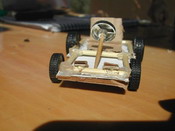 |
|
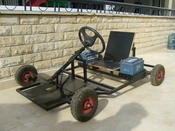 |
Shopping for parts / Original plan-ideas / Building the Go-Kart / Final product / More pictures
VIEW GO-KART FLYER (pdf file)
| When the grade 12 physics class started building a go cart in February 2006 together with WESC, the idea was to build a go kart that basically had the layout of a normal go kart, except for the fact that it was not supposed to produce any type of emission. In other words we had to resort to an alternative source of energy. At first we thought about building a solar powered go kart, and the idea seemed quite good at first, especially since the sun is always shining in Egypt, but as we thought about the design and cost of building a solar powered go kart we ran into some problems. First of all solar panels are quite expensive, we looked at prices for rather small solar panels and saw that these were already over 100$US a piece, plus they would add a considerable amount of weight to an already quite heavy chassis. Second they would have to be mounted all around the go-kart in order to achieve a good amount of energy being produced from the panels. With this in mind we started looking at some alternatives: we thought about building a fuel cell and using it as our main source of propulsion, but again the cost was simply too much for us. So we came to the conclusion that we would build an electric go kart powered by car batteries (but rechargeable by solar energy). We went out and bought 2 car batteries, each putting out around 70 Amps. With the batteries purchased, we also bought a used Hyundai steering column (including the steering wheel and the steering shaft) suspended by ball bearings. This was quite useful, as the cover offered a few mounting points, so we could use it to solidly attach the shaft to our chassis. |
We were ready for a visit to WESC, to prepare the barebones chassis with proper dimensions we had calculated from a 1/20 scale model. We spent the next few weeks building the go-kart piece by piece. After the chassis was built, we mounted the rear axle, welded the front wheel attachments, configured a break, engine, and battery mount, as well as placing the seat on the cart. The last steps were to properly mount the engine and connect it to the axle with a motorbike chain, and with a gear ratio around Written by: Felix Petzsche |
In the city shopping for parts
Purchasing our Varta car batteries
February 21.2006

Our first day at WESC, Felix is designing the 1/20 scale model of the go kart
The basic scetch of what it is all supposed to look like
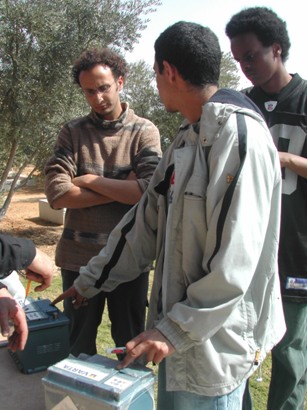
Kary and Shmark checking whether to wire the batteries in a Series of Parallel circuit
February 25.2006
The first metal work for the chassis being done, Kary paying close attention...
The first look at the complete barebone chassis
Calculations being done on certain dimension values for the chassis
February 27.2006
Felix and Waleed Examining the front skid plate that was installed while we were gone
Hadir attaching the mounts for the seat
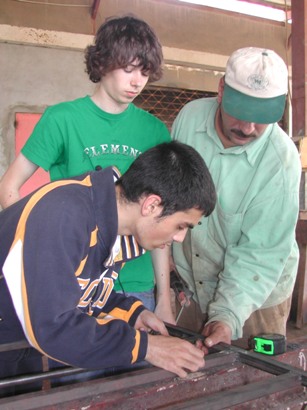
Installing the Brake mount with the worker in charge of the welding
Waleed attempting to weld a part of the brake mount
March 14.2006
The go kart is coming together nicely, batteries mounted, chair fixed, and steering being prepared
Everyone looking focused as we try to tune the brake
Sometimes things got a bit boring, but that is part of the process
After the Science fair, our go kart was complete and the end result impressed us all
The go kart sitting at the side entrance of CISE looking proper for the first time.
Another angle of the kart
Felix ready to take it for a spin
In Conclusion it seems we can all be satisfied with the results, even though we were uncertain how everything was going to work out at times, we managed to put it all together into quite a respectable package. All of us gained practical experiance, as well as team coordination skills, as all of us had parts to focus on and people to work with. It was a great experiance for all of us and we are all glad it worked out the way it did. A big thank you to WESC for supplying us with a workshop, a team of mechanics and various materials we needed to complete the project.
Environmentally Friendly Go-Karts
Take CISE By Storm!
By Kirolos Iskander
|
More Pictures
Here are a few more pictures taken during the project.
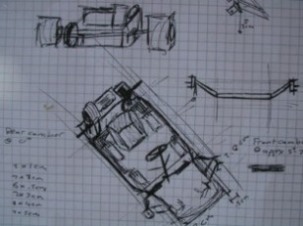
Grade 12 Physics
Teacher: Ian Wikarski
Website by: Felix Petzsche
VIEW GO-KART FLYER (pdf file)
Shopping for parts / Original plan-ideas / Building the Go-Kart / Final product / More pictures
CISE official website
(you need to be connected to the internet)